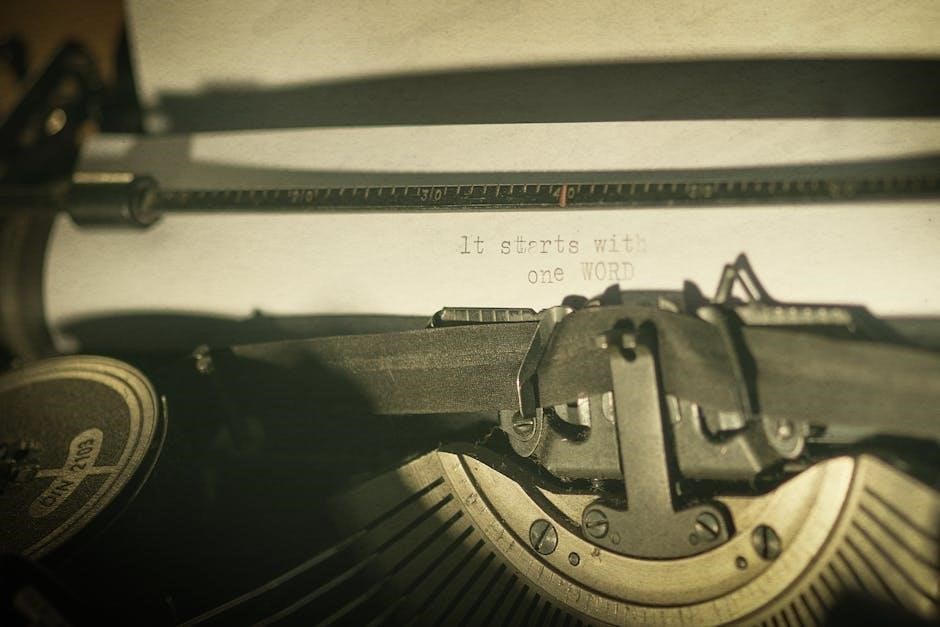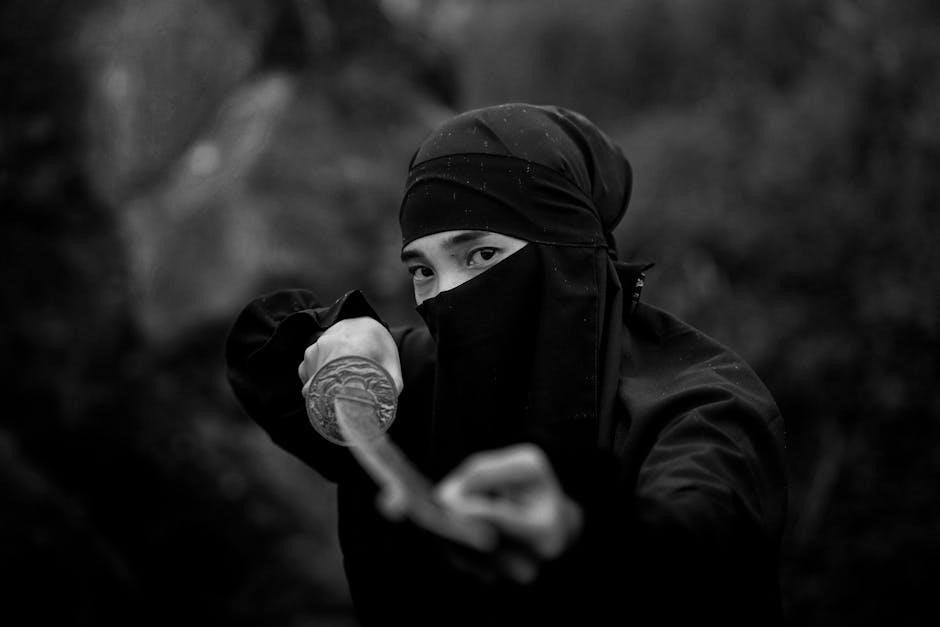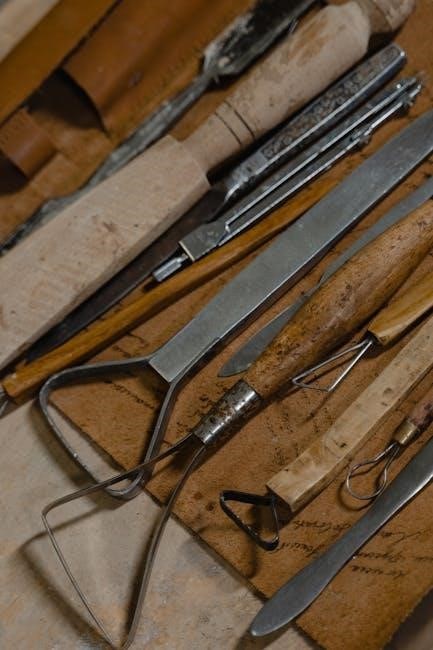The path of the ninja demands unwavering dedication, blending stealth, strategy, and discipline into a unique art of covert action and survival.
What Defines a Ninja?
Defining a ninja extends far beyond popular depictions of shadowy assassins. Historically, they were versatile operatives specializing in unconventional warfare – espionage, sabotage, infiltration, and reconnaissance.
Unlike samurai, bound by a strict code of honor and open combat, ninjas operated in the shadows, prioritizing mission success above all else. Their skillset encompassed a broad range of disciplines, from martial arts and weaponry to disguise, escape, and survival techniques.
A true ninja wasn’t defined by a specific fighting style, but by adaptability and resourcefulness. They utilized any means necessary to achieve their objectives, blending into their surroundings and exploiting weaknesses. Discretion and secrecy were paramount, making their true identities often shrouded in mystery.
Historical Context: Origins and Evolution
The origins of the ninja trace back to feudal Japan, emerging during the 14th century as specialized mercenaries. Initially, they arose from clans in the Iga and Kōga provinces, regions known for their rugged terrain and political instability.
These early ninjas were employed by daimyo (feudal lords) for tasks samurai couldn’t – or wouldn’t – undertake. Over time, ninja families developed unique skills and traditions, passed down through generations.
The Sengoku period (1467-1615), a time of constant warfare, saw the ninja’s influence peak. However, with the unification of Japan under the Tokugawa shogunate, their role diminished. Despite this, ninja skills persisted, evolving into intelligence gathering and even serving as bodyguards. Myths and legends surrounding them grew, shaping their enduring image.

Physical Conditioning – The Ninja Body
A ninja’s physique was paramount, demanding peak performance in strength, endurance, and agility – honed through rigorous, relentless training regimens.
Endurance Training: Running and Climbing
Developing exceptional stamina was crucial for ninjas, requiring long-distance running across varied terrain – mountains, forests, and even urban environments. Training wasn’t simply about speed, but sustained effort over extended periods. Daily runs, often carrying weighted packs, built leg strength and cardiovascular resilience.
Climbing proficiency was equally vital. Ninjas needed to scale walls, trees, and cliffs silently and efficiently. This involved specialized techniques focusing on grip strength, balance, and utilizing minimal handholds. Practice included traversing obstacles using ropes and grappling hooks, mastering both ascending and descending techniques. Furthermore, training incorporated climbing in all weather conditions, preparing for real-world operational demands. The goal was to move like shadows, undetected and unstoppable.
Strength Training: Bodyweight Mastery
Ninjas relied heavily on bodyweight training, forging incredible strength without the need for cumbersome equipment. This approach emphasized functional strength – the ability to perform real-world tasks effectively. Daily routines included numerous push-ups, progressing from standard variations to one-handed attempts, building upper body power and stability.
Lower body strength was developed through squats, lunges, and plyometrics, enhancing jumping ability and agility. Core strength was paramount, cultivated through planks, sit-ups, and twisting exercises, providing a solid foundation for all movements. Pull-ups, utilizing trees or purpose-built frames, built back and arm strength essential for climbing and maneuvering. The focus wasn’t on bulk, but lean, functional muscle capable of sustained exertion and precise control.
Flexibility and Agility: The Supple Warrior
A ninja’s movements were fluid and adaptable, demanding exceptional flexibility and agility. Rigorous stretching routines were integral, targeting all major muscle groups to increase range of motion and prevent injury. Daily practice included deep stretches held for extended periods, improving elasticity and joint health.
Agility drills focused on quick changes in direction, balance, and coordination. Cone drills, footwork ladders, and simulated obstacle courses honed reflexes and spatial awareness. Practitioners would also train in acrobatic movements – rolls, flips, and vaults – to navigate challenging terrain and evade capture. This wasn’t simply about physical capability; it was about cultivating a body that responded instinctively, allowing for silent, graceful, and unpredictable movement.

Mental Discipline – The Ninja Mind
Cultivating inner strength, a ninja mastered focus, emotional control, and strategic thought, essential for navigating perilous missions with unwavering resolve.
Focus and Concentration Techniques
The ninja’s mind is a fortress, impenetrable to distraction. Achieving this requires rigorous training of the senses and the will. Mokuso, or silent meditation, forms the cornerstone of this discipline. Practitioners would sit in seiza, a formal kneeling position, and empty their minds, focusing solely on their breath.
Beyond meditation, shugyo – intense, repetitive drills – honed concentration. Whether practicing weapon forms or stealth movements, the ninja performed each action with deliberate precision, eliminating extraneous thought. Visualization played a crucial role; mentally rehearsing missions, anticipating obstacles, and perfecting responses.
Furthermore, sensory deprivation exercises, like operating in complete darkness or under intense noise, forced the ninja to rely on heightened awareness and internal focus. These techniques weren’t merely about blocking out distractions, but about actively choosing where to direct one’s attention, a skill vital for survival and success.
Overcoming Fear and Maintaining Composure
A ninja’s greatest enemy isn’t a sword or a guard, but their own fear. Training wasn’t simply about physical prowess, but about mastering the mind’s response to danger. Fudoshin – “immovable mind” – was a core principle. This meant cultivating a mental state unaffected by external events, remaining calm and centered even under extreme pressure.
Exposure therapy was a key method. Ninjas deliberately confronted their fears – heights, darkness, confined spaces – gradually increasing the intensity to build resilience. Controlled breathing exercises, like kokyu-ho, helped regulate the nervous system, preventing panic.
They also practiced detaching from the outcome. Success or failure wasn’t the primary focus; the emphasis was on executing the mission with unwavering focus and discipline. This acceptance of uncertainty allowed them to react decisively, even in chaotic situations, maintaining composure when others would crumble.
Strategic Thinking and Observation Skills
The ninja wasn’t a brute, but a strategist. Success hinged on meticulous planning and keen observation. Before any mission, extensive reconnaissance was crucial – not just of the target, but of the surrounding environment, guard patterns, and potential escape routes. This wasn’t passive observation; it was active analysis.
Ninjas were trained to notice minute details others overlooked: a loose tile, a change in guard rotation, a subtle scent. They employed the art of kanzen – complete awareness – absorbing information from all senses. This data was then processed to anticipate enemy movements and exploit weaknesses.
Strategic thinking involved visualizing multiple scenarios and developing contingency plans. A ninja never relied on a single approach, always prepared to adapt and improvise. They understood that information was power, and careful observation was the key to unlocking it.

Stealth and Infiltration Techniques
Mastering silence and shadow, ninjas employed techniques to move undetected, blending into their surroundings and bypassing defenses with calculated precision.
Camouflage and Concealment
The art of becoming unseen was paramount. Ninjas didn’t simply hide; they became the environment. This involved utilizing natural materials – leaves, mud, charcoal – to disrupt their outline and blend with the terrain. Clothing was often dark or muted, chosen to match the prevailing conditions.
Beyond visual deception, ninjas understood scent control. Masking their odor with local vegetation was crucial, preventing detection by animals or keen-nosed guards. They also mastered the use of shadows, moving along them to minimize visibility and exploiting darkness to their advantage.
Concealment wasn’t limited to the body. Ninjas would carefully observe their surroundings, identifying natural hiding places – dense foliage, hollow logs, even rooftops – and utilizing them effectively. This required patience, observation, and a deep understanding of the environment.
Lock Picking and Security Bypass
Gaining access undetected often required circumventing physical barriers. While not always focused on brute force, ninjas possessed a working knowledge of lock mechanisms common to their era. Simple pin tumbler locks were vulnerable to manipulation with specialized tools – thin metal picks and tension wrenches – allowing silent entry.
Beyond locks, ninjas understood structural weaknesses. Identifying poorly secured windows, removable panels, or hidden passages was vital. They were adept at scaling walls, utilizing ropes and grappling hooks to bypass ground-level defenses. Observation was key; noting guard patrol routes and identifying blind spots informed their approach.
Furthermore, ninjas employed misdirection and social engineering. Creating diversions or impersonating individuals with legitimate access could bypass security altogether, demonstrating that intelligence often trumped technical skill.

Weaponry – Tools of the Trade
A ninja’s arsenal wasn’t about overwhelming force, but practical tools for deception, infiltration, and swift, decisive action when direct confrontation was unavoidable.
Shuriken: Throwing Star Mastery
Shurikenjutsu, the art of the throwing star, was a crucial, yet often misunderstood, element of the ninja’s skillset. These weren’t simply flung as lethal projectiles; their primary function was often diversionary. A well-aimed shuriken could draw a guard’s attention, create a distraction, or disrupt an opponent’s focus, allowing for a more advantageous approach or escape.
Different shuriken designs – bo-shuriken (straight spikes) and hira-shuriken (flat, multi-pointed stars) – offered varied tactical applications. Mastery required rigorous training in grip, stance, throwing angles, and understanding wind resistance. Accuracy wasn’t solely about power; it was about precision and exploiting vulnerabilities. Effective shurikenjutsu demanded a deep understanding of anatomy, aiming for non-lethal, yet debilitating, points to hinder rather than instantly kill.
Close-Quarters Combat: Striking and Grappling
Taijutsu, the art of body skill, formed the core of a ninja’s unarmed combat prowess. Unlike formalized martial arts focused on honorable duels, ninjutsu’s close-quarters fighting prioritized efficiency and ruthlessness. Strikes targeted vulnerable points – eyes, throat, groin, and joints – aiming to incapacitate quickly. Grappling techniques weren’t about dominance, but control and manipulation, utilizing throws, joint locks, and pressure point applications to subdue opponents.
Emphasis was placed on adapting to any environment, fighting in darkness, confined spaces, or uneven terrain. A ninja’s movements were fluid and unpredictable, blending striking with grappling seamlessly. Footwork was crucial, enabling rapid repositioning and evasion. The goal wasn’t a prolonged fight, but swift neutralization, allowing for a silent retreat or continuation of the mission.
Joint Locks and Pressure Point Attacks
Beyond brute force, ninjutsu heavily utilized kuzushi – breaking an opponent’s balance – and precise targeting of anatomical weaknesses. Joint locks (kansetsu-waza) weren’t about causing permanent damage, but controlling movement and forcing submission. These techniques exploited the natural range of motion, hyper-extending or twisting joints to create pain and disable an attacker.

Pressure point attacks (kyusho-jutsu) targeted vital points along the body’s energy pathways, disrupting nerve function and causing temporary paralysis or unconsciousness. Knowledge of anatomy was paramount; a skilled ninja could incapacitate an opponent with minimal force. These techniques were often combined with strikes and grappling, maximizing their effectiveness. Mastery required years of dedicated practice and a deep understanding of the human body.
Defensive Tactics: Evasion and Blocking
A ninja’s defense wasn’t about meeting force with force, but avoiding it altogether. Tai sabaki – body evasion – was central, utilizing footwork and body shifting to move off the line of attack. Blocking (uke) wasn’t rigid; it involved redirecting an opponent’s energy, using circular motions to deflect blows rather than absorbing impact.
Emphasis was placed on anticipating attacks through observation and reading an opponent’s intent. Rolling, ducking, and slipping attacks were favored over direct confrontation. When blocking was unavoidable, techniques focused on minimizing damage and creating openings for counterattacks. The goal wasn’t simply to survive, but to turn an opponent’s aggression against them, maintaining constant movement and control.

Espionage and Information Gathering
Intelligence was paramount; ninjas excelled at discreet observation, cultivating networks, and extracting vital secrets from enemies without detection or conflict.
Surveillance and Reconnaissance
Effective surveillance formed the bedrock of any successful ninja mission. It wasn’t merely about seeing, but about understanding – discerning patterns, identifying vulnerabilities, and anticipating movements. Ninjas employed techniques like makura-gari (pillow scouting), listening through walls, and utilizing concealed observation posts.
Reconnaissance involved detailed mapping of terrain, fortifications, and guard rotations. They’d meticulously document entry and exit points, noting blind spots and potential escape routes. Blending into the environment was crucial; adopting disguises, mimicking local customs, and moving with the shadows allowed them to gather information undetected.
Detailed reports, often utilizing coded language or symbolic representations, were then relayed back to their handlers, providing critical intelligence for planning and execution. The ability to remain unseen and unheard was the ninja’s greatest asset during these vital operations.
Code Creation and Decryption
Secure communication was paramount for ninjas, necessitating sophisticated methods of code creation and decryption. Simple substitution ciphers were insufficient; they employed complex systems incorporating symbols, numbers, and even seemingly innocuous everyday objects to represent letters or entire phrases.
Ikiryo, a method utilizing strategically placed dots and dashes, was common. More advanced techniques involved kirijime, where messages were hidden within seemingly ordinary documents using invisible ink or microdots. Decryption required specialized knowledge and often, a key – a pre-arranged codebook or a shared understanding of the system;
Ninjas also utilized steganography, concealing messages within other forms of communication, like poems or artwork. Maintaining the secrecy of these codes was vital; compromised communication could mean mission failure, or worse, capture and execution.
Disguise and Impersonation
Mastering disguise was crucial for a ninja’s success, allowing infiltration into enemy territory and gathering vital intelligence. This wasn’t merely about changing clothes; it involved a complete transformation of mannerisms, speech patterns, and even gait.
Hensojutsu, the art of disguise, encompassed adopting the roles of merchants, farmers, monks, or even high-ranking samurai. Ninjas meticulously studied their targets, replicating their behaviors and acquiring appropriate props – tools, clothing, and documentation – to convincingly portray the assumed identity.
Voice modulation, practiced through rigorous training, was essential. Makeup and prosthetics were utilized to alter facial features. A ninja’s ability to blend seamlessly into any environment depended on their dedication to detail and unwavering commitment to maintaining the illusion.

Survival Skills – Thriving in the Wild
A ninja’s life often meant operating far from civilization, demanding mastery of wilderness survival – navigation, foraging, shelter, and firecraft were vital.
Wilderness Navigation
For the ninja, becoming lost was not an option. Mastery of wilderness navigation relied heavily on observing natural signs – the sun’s path, star constellations, prevailing wind directions, and the growth patterns of vegetation.
Detailed mental mapping was crucial; ninjas memorized terrain features, landmarks, and potential escape routes during reconnaissance missions. They understood how to utilize moss growth on trees to determine cardinal directions, and could estimate distances by counting paces, calibrated to their individual stride.
Furthermore, ninjas employed rudimentary compasses constructed from magnetized needles and water, and were skilled in creating and interpreting basic maps using charcoal and natural surfaces. This knowledge ensured they could move unseen and efficiently through any environment, day or night.
Foraging for Food and Water
A ninja’s survival often depended on their ability to live off the land. Extensive knowledge of edible plants, roots, berries, and fungi was paramount, alongside understanding which were poisonous – a potentially fatal mistake.
Locating potable water sources was equally vital. Ninjas knew how to identify springs, collect dew, and even extract moisture from plants. They understood techniques for purifying water using charcoal filtration or boiling, minimizing the risk of illness.
Small game trapping and fishing skills supplemented their foraging efforts, providing essential protein. Resourcefulness meant utilizing every part of an animal or plant, minimizing waste and maximizing sustenance during prolonged missions.
Shelter Building and Fire Starting
Essential for prolonged operations, a ninja needed to construct effective shelters rapidly. Utilizing natural formations like caves or dense foliage, they’d build lean-tos or simple huts camouflaged with local materials. Insulation against the elements was crucial for maintaining energy and avoiding detection.
Fire provided warmth, cooked food, purified water, and psychological comfort. Ninjas mastered friction-based fire starting methods – bow drill, hand drill – and understood tinder selection (dry grasses, birch bark). Maintaining fire discipline, minimizing smoke visibility, was paramount.

Shelter and fire weren’t luxuries; they were vital components of a ninja’s ability to endure and operate effectively in hostile environments.
Loyalty and Duty
A ninja’s existence revolved around unwavering loyalty to their clan and lord. Duty superseded personal desires; missions were accepted without question, and failure was rarely an option. This commitment stemmed from a deeply ingrained code of honor and a sense of obligation.
Betrayal was the ultimate transgression, punishable by severe consequences, often death. Ninjas understood that their effectiveness relied on absolute trust within the group. Maintaining secrecy and protecting the clan’s interests were paramount.
This dedication wasn’t blind obedience, but a calculated acceptance of responsibility. A ninja served a purpose, and fulfilling that purpose with unwavering loyalty defined their path.
Honor and Integrity
Despite their reputation for deception and covert operations, ninjas adhered to a strict code of honor and personal integrity. This wasn’t about public acclaim, but internal principles guiding their actions. A ninja’s word was their bond, even in the shadows.
While missions often required subterfuge, unnecessary cruelty or dishonorable acts were frowned upon. Integrity meant completing the assigned task efficiently and effectively, without resorting to gratuitous violence or breaking promises.
Maintaining self-respect and upholding a personal moral compass were crucial. A ninja’s honor wasn’t defined by societal norms, but by their commitment to their principles and their clan’s values.
Adaptability and Resourcefulness
The ninja’s greatest strength wasn’t brute force, but their remarkable ability to adapt to any situation. Missions rarely unfolded as planned, demanding quick thinking and improvisation. Resourcefulness meant utilizing whatever was available – the environment, discarded objects, even an opponent’s weaknesses – to achieve the objective.
A true ninja could turn a simple tool into a weapon, or a disadvantage into an opportunity. They were masters of making do with limited resources, relying on ingenuity rather than elaborate equipment.
This flexibility extended to their mindset; a ninja remained calm and focused under pressure, adjusting their tactics as needed to overcome obstacles and ensure mission success.

Advanced Techniques – Beyond the Basics
Master ninjas delved into esoteric arts – poisons, explosives, and psychological manipulation – demanding extensive knowledge and careful, calculated application of skills.
Use of Poisons and Medicines
A ninja’s understanding of natural substances was crucial, extending far beyond simple weaponry. Knowledge of botany allowed for the creation of potent poisons, often derived from plants and insects, used for subtle incapacitation or, when necessary, silent elimination.
However, this knowledge wasn’t solely destructive. Ninjas were also skilled in herbal medicine, capable of treating wounds, alleviating pain, and countering the effects of certain toxins. Antidotes were painstakingly prepared and carried, alongside remedies for common ailments encountered during long missions.
The application of these substances required precision and discretion. Poisons were delivered through various means – blowdarts, concealed blades, or even contaminated food and water – always prioritizing subtlety. Understanding dosage and physiological effects was paramount, ensuring the desired outcome without detection.
Explosives and Demolitions (Historical Context)
While often romanticized, the ninja’s use of explosives was pragmatic and limited by the technology of the time. Early forms weren’t sophisticated; they primarily involved gunpowder – introduced to Japan in the 16th century – packed into ceramic or metal containers. These were used to create diversions, breach fortifications, or ignite fires.
Ninjas didn’t typically engage in large-scale demolitions. Their expertise lay in small, targeted explosions designed to disrupt enemy movements or create escape routes. They understood the properties of gunpowder and experimented with different mixtures to control burn rates and explosive force.
It’s crucial to understand this wasn’t about widespread destruction, but tactical advantage. The creation and handling of these devices were dangerous, requiring careful preparation and a thorough understanding of potential consequences.
Psychological Warfare
A ninja’s greatest weapon wasn’t always steel or poison, but the manipulation of the enemy’s mind. Psychological warfare aimed to sow discord, fear, and confusion, weakening resolve before physical confrontation. This involved spreading rumors, creating illusions, and exploiting existing anxieties within the target’s ranks.
Techniques included leaving unsettling signs – strange symbols or ominous messages – to create a sense of dread. Mimicking enemy voices or creating phantom sounds disrupted sleep and fostered paranoia. The goal wasn’t simply to frighten, but to erode trust and decision-making capabilities.
Understanding enemy psychology was paramount. A skilled ninja would tailor their tactics to exploit specific vulnerabilities, turning perceived strengths into weaknesses. This subtle, insidious approach often proved more effective than direct assault.
